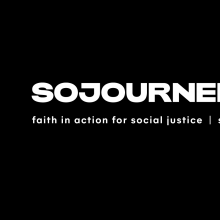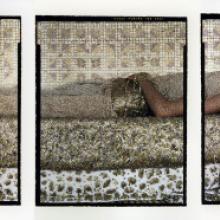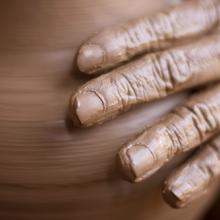Art
The Noah epic releasing in theaters this Friday promises to be controversial, with director Darren Aronofsky calling it “the least biblical biblical film ever made.” As the story of Noah remains near and dear to people of many faith traditions, the film has already unleashed a flood of criticism.
In an interview, Aronofsky described where he got the idea for the film, how he plans to respond to critics, and why he focuses the film on themes of justice vs. mercy.
THE GRAPHIC NOVEL Radical Jesus, edited by Paul Buhle, has three distinct sections offering different expressions of Jesus’ life and social message. The brevity of the graphic novel medium allows the writers to construct a clear and distinct message in a moving art form.
Part one, “Radical Gospel,” illustrated by Sabrina Jones, uses biblical quotes to construct a visual story that connects the words of Jesus to modern situations. The black and white ink styling is simple yet profound.
While Jesus and his disciples are portrayed as first century Jews, the people Jesus interacts with and tells parables about are all in modern dress. This puts Jesus in an accessible conversation not only with his disciples, but also with the reader. In a collection of Jesus’ sayings from the Sermon on the Mount, the art drives home the emotional impact of his words.
Jones does not shy away from the radical implications of Jesus’ message. My favorite of her modern interpretations is an image of the destruction wreaked by the 9/11 attacks, contrasted with Jesus’ reference to the temple in Jerusalem, where he exclaims, “The day will come when there isn’t one stone left on top of another that is not thrown down.”
Understanding the process of turning an implement of death and violence into a tool for creativity and imagination is one part of the strategy. In doing so, there is hope that participants in such an event will begin to reimagine their own world and how they engage it. After all, true change first begins with imagining the possibility of such transformation.
Further, Reyes hopes to challenge U.S. citizens to consider their relationships with guns, and moreover, the impact that value has on people in other countries. Again, in the NPR story, Reyes explains, “We have to be allowed to ask questions. If you are not allowed to ask questions, you are not free."
An Iraqi woman dons a black hijab but bares her thighs. A Lebanese woman wearing a sheer blouse curls up on a bed, both innocent and seductive. An attractive young Iranian couple shares breakfast at a small table, seemingly oblivious to the tank looming just a few yards away.
There are no harems, belly dancers, or male oppressors in this photography show, nor any of the other Middle Eastern stereotypes that Westerners generally associate with that far away, often misunderstood, region.
“She Who Tells a Story,” a photo exhibit now showing at Boston’s Museum of Fine Arts and headed to other U.S. museums, features the work of 12 women from the Middle East who shatter stereotypes with works that are provocative, beautiful, mysterious, and surprising, all at the same time.
I’VE RECENTLY spent time researching the vision of the U.S. through the lens of one film for every state, following the intuition that, as most movies are set in Southern California or New York (and there’s a lot more America where those didn’t come from), we need to examine Fight Club and On the Waterfront, Brokeback Mountain and Nashville no less than The Wizard of Oz and Gone with the Wind to begin to capture the American dream life. It seems obvious, but it’s often dismissed: Contrasts between the states are mighty and rich. A Wyoming plain and a Sonoma vineyard, Hoboken and Harlem and Hot Springs, the Florida Keys and the Swannanoa Valley are all magnificent intersections of dreams and mistakes, which in honest art allows them to be places where the past can be faced.
And on that note, here’s my list of the 10 best U.S. films released in 2013:
The new Criterion Blu-ray John Cassavetes box set includes The Killing of a Chinese Bookie, the best entry to his work: A grimy thriller about one man trying to make art against the odds.
Jeff Bridges and Rosie Perez show us something more of how to be human in Fearless (newly available on Blu-ray), about a man who needs to die before he can live (and love).
Way back in the day (circa 2004), Switchfoot's lead singer, Jon Foreman, was asked if the band is a “Christian” band. Even though it's been a while, his response is worth looking at again.
Still Shining
David Hilfiker is a retired inner-city physician and writer on poverty and politics who has Alzheimer’s. He writes about his experience, with the hope of helping “dispel some of the fear and embarrassment” that surrounds this disease, on his blog “Watching the Lights Go Out.” www.davidhilfiker.blogspot.com
Transported
Laura Mvula is a British, classically trained musician, songwriter, and former choir director whose debut album,Sing to the Moon,is a lush fusion of soul, jazz, gospel, and pop. While not overtly “about” faith, her arrangements are imbued with spiritual longing and visions of beauty. Columbia
It didn’t take long to erase the gun.
Greg Bokor’s ArtPrize drawing of an assault rifle at Grand Rapids’ Fountain Street Church was rubbed out Sept. 21 after the public was invited to wield erasers imprinted with sorrow.
Normally festive art lovers obliterated the killing machine with erasers bearing the names of 83 massacred children and adults. They included Jesse Lewis, age 6, one of 20 children killed at Sandy Hook Elementary School last December; Veronica Moser-Sullivan, also 6, youngest of 12 people killed in the 2012 Aurora, Colo. movie-theater slaughter; and the 45 victims of the Columbine High School and Virginia Tech shootings.
Within hours, the public had rendered the AR-15 just a faintly visible image. It was a powerful symbol of what many of us would like to see happen to these weapons of death so easily available to mentally deranged people seeking sick revenge.
Tragically, in real life, it is the children and other victims who have been so easily erased from our consciousness.
Meet “Our Lady of Perpetual Exhaustion,” a saint everyone probably can relate to.
The chaos of everyday life and the methods we use to overcome it are on display at the “Our Lady of Perpetual Exhaustion” exhibit in two D.C. galleries.
“We all have coping mechanisms,” said Cynthia Farrell Johnson, creator of the exhibit’s theme. “And for most of us, part of our coping mechanism is our spiritual life.”
Biblical writers suggest that God loves a holy mess. They compare God’s creative spirit to a strong wind, and we all know what happens when a powerful wind blows through our windows or through our lives — everything gets upended! One image in Genesis has God scooping up a bit of earth to create us. Yes, God had to get some dirt under the fingernails in order to bring us about.
Jesus was creative in how he touched and healed people, often making himself ritually unclean in the process. He embraced his uncleanliness.
Sadly, many religious institutions discourage us from doing the same.

Uncreation photo courtesy Pontifical Council for Culture (http://bit.ly/10lOLTr)
For centuries, popes sponsored the work of artists such as Michelangelo, Raffaello, or Bernini, who went on to create some of their masterpieces within the very walls of the Vatican.
Yet over time, the marriage between art and faith grew stale — the Vatican’s culture minister even called it a “divorce” — with the Roman Catholic Church finding itself estranged from the art world it did so much to create.
Now, in a bid to revive its ancient tradition of arts patronage, the Holy See will participate with its own pavilion at the 2013 Venice Biennale, a leading international arts festival.
IF THEY HAD met, Aaron Swartz and Vernon Bowman probably wouldn't have hit it off. The 26-year-old Brooklyn, N.Y. computer whiz and the 75-year-old Indiana grain farmer might have been from different planets. But they were brothers-in-arms in a historic struggle over the shape of the 21st century economy and culture. Each, in his own way, has challenged the iron, unyielding hegemony of copyright law that increasingly protects permanent, private, for-profit ownership of artistic creations, scholarly research, and the very processes of life itself.
Aaron Swartz won't be around to see the outcome of this struggle.
Swartz was a successful internet innovator who used his wealth and position to promote "free information." In 2008, he wrote a program that was used to liberate thousands of public-domain federal court records from a site that was charging 10 cents per page for their use. More recently he used his access to the M.I.T. computer network to execute a massive robo-download of millions of scholarly articles from the subscription database JSTOR. The idea was to make the scholarship available free.
After he was caught, JSTOR reached a civil settlement with Swartz that included his surrender of the hard drives containing the articles and then treated the case as closed. But federal prosecutors decided to throw the book at Swartz. He was under a felony indictment for computer fraud and facing a possible 35-year prison sentence. Finally, in January, Swartz, who had a history of depression, killed himself. His parents blamed overzealous prosecutors for his death.
Almost two years ago, I took a titanic risk. If you look at things from an earthbound perspective, what I did is: I took my livelihood, and my children's provision, in my hands alone. I quit my job at The News & Observer, a major, Pulitzer-prize-winning newspaper where I earned a decent salary and reached 150,000 to 200,000 readers on any given day.
The decision was a long time coming — my whole adult life, really. Before I ever started my first newspaper job in 2000, I’d wanted to help people explore deeper things than just tax policy, or crime, or environmental regulation. These just skim the surface of who we are as humans: why we share or hoard, why we hurt or protect one another, what we owe to Mother Earth.
What I found as a newspaper reporter was that I had no choice but to skim the surface of things. There’s not enough space to go deeper, but, more importantly, deeper takes you into hypothesis, not fact — and hypothesis is a leap of faith. What you find when you go deeper depends a lot on the gear you’re wearing when you dive. I’m cloaked in Bible stories and Christian tradition, and therefore I live in hope that there’s a Creator and that this God is working quietly to heal the world.
I read recently in Psalm 27:
“The Lord is my light and my salvation —
whom shall I fear?
The Lord is the stronghold of my life —
of whom shall I be afraid?”
How is it possible that the creative life can feel simultaneously self-giving and narcissistic? On the one hand, the artist, or musician, or writer has a gift that not everyone has. And because paintings and songs and books give other people great joy – and might even change their lives — those gifts must be shared. But that means the artist herself must be shared, and that’s the problem.
For the artist, self-expression is unavoidable – it is part of the job description. As a songwriter, my raw material is the world as I observe it. That’s all I’ve got. The most realistic painter or sculptor still has to rely on his own vision. Even as a journalist, I have to draw upon my five senses, my own mind and my own experiences. Even as I tell someone else’s story, it is in part my story. I can’t tell your story without filtering it through my story; it’s how we make sense of new information. I’m only human, after all.
We were walking up the beach, on the sand as the tide moved out toward the ocean. I was holding Zeke's hand, talking with him about sea things. "I didn't know jellyfish swam this close to the shore during the spring," he said in 5-year-old wonderment. "I bet that drift wood is as old as The Old Man and the Sea. I think a horseshoe crab's blood can be used to treat cancer."
"Look," I said.
"What is it, Dad?" he asked.
I picked up a shell out of the deep, hot sand and held it in my open hand.
In the middle of the 16th century, Catholic bishops and theologians met sporadically in the city of Trento in northern Italy to discuss the church's response to the Reformation. Over the course of 18 years, the Council of Trent produced documents correcting abuses like indulgences and other corruption.
In 1564, the council ordered that some naked figures in Michelangelo's massive "Last Judgment" fresco in the Sistine Chapel be covered up as a result of the council's dictate that "all lasciviousness be avoided; in such wise that figures shall not be painted or adorned with a beauty exciting to lust."
It will be difficult for critics to compare Michelangelo's nudes with the ones photographed by the Rev. John Blair. Just after the Episcopal Diocese of Missouri launched an investigation of the St. Louis priest, many of his photos of nude models were removed from the Internet.
And yet the diocese's disciplinary board, whose members will decide if Blair's photography constitutes sexual misconduct, will try to answer the same question as Trent's participants 450 years ago: How does the church recognize the beauty of art that depicts God's creation — the human form — without seeming to condone "a beauty exciting to lust"?
Two years after the Sept. 11 attacks, Timothy O'Leary sat in an audience of 2,000 New Yorkers listening to the Brooklyn Philharmonic perform a concert about terrorism — the 1985 murder of an American tourist by members of the Palestine Liberation Front on a Mediterranean cruise ship. It was one of the most powerful moments he'd ever had in a theater.
Terrorism stories are rarely happy stories, and yet the path O'Leary has taken — from bringing the controversial opera "The Death of Klinghoffer" to St. Louis last year to a Sept. 11 memorial concert on Sept. 9 — ends with a hopeful, permanent pairing of faith and the arts in St. Louis.
Hello fellow Sojourners!
This is a brief missive for your enjoyment. I just returned from the Wild Goose Festival in Corvallis, Ore.
Yes, Oregon and not North Carolina. You see, in a fit of wisdom, the good people of Wild Goose found a west coast location. I hope it worked well for them because I'm sold on the place.
I wish you could have been there. It was amazing. To tantalize you into attending next year, here (in no particular order) are Nine Good Reasons to Attend The Wild Goose Festival.
1. There are no bugs.
None. Well, some flies, but this is Oregon and not North Carolina and though the nights are chilly and the mornings moreso (I awoke the last morning to see my breath in the air), the sun arose and everything warmed up to make for some of the most beautiful weather you'll ever experience.
2. All the notables are there.
Rachel, Richard (and Richard), Brian, Nadia, Gareth, Bruce, Christian, Amy, Yvette, Hilary, Greg, Steve...So many people to meet and to know.
National Geographic Traveler Photo Contest selects 11 winners out of 12,000+ entries --- Kirby Ferguson's TED talk on originality, creativity, and remixing --- billboards play on Shell's slogan, stick it to the corporate oil giant --- world's first all-female Street Art conference kicks off --- pickin' tunes from the Milk Carton Kids. See these and more in today's Links of Awesomeness...













